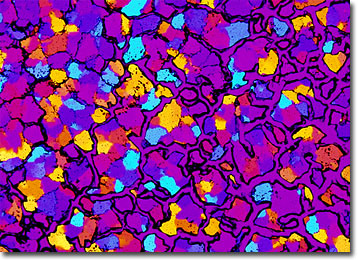Polarized Light Microscopy Digital Image Gallery
Vitamin D
The term vitamin D refers to two fat-soluble compounds that play an important role in the body’s metabolism of calcium and phosphorous. Calciferol, or vitamin D2, and cholecalciferol, or vitamin D3, are now understood to be hormones, but continue to be described as vitamins due to their historical classification as such.

View a second image of Vitamin D
The United States Food and Drug Administration’s Recommended Dietary Allowance (RDA) of vitamin D is 10 micrograms for men, women, and children. Most people are able to easily obtain such a dosage through regular exposure to sunlight, which reacts with the vitamin D precursor, 7-dehydrocholesterol, present in the skin to produce adequate levels of the vitamin. In some northern locations during winter or areas suffering from severe air pollution, however, individuals may not come into contact with enough ultraviolet rays to produce sufficient quantities of vitamin D. In such cases, bodily vitamin D levels can be supplemented through the diet by consuming items such as liver, fish oils, and fortified milk.
An example of the benefits of moderation, both an excess and a deficiency of vitamin D can be hazardous to one’s health. Prolonged exposures to high levels of vitamin D, sometimes termed hypervitaminosis D, can often be diagnosed through observation of small, yellowish colored patches on the skin and in the eyes, and is further characterized by fatigue, decrease in appetite, muscle weakness, nausea, and vomiting. Also, since calcium absorption is affected by the vitamin, hypercalcemia, or an overabundance of calcium in the blood, may occur. Contrariwise, the lack of sufficient quantities of vitamin D in the body is most commonly associated with rickets and osteomalacia, both of which are characterized by serious problems with the bones.
